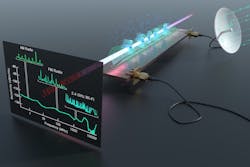Laser-excited Rydberg atoms above a microwave waveguide detect the entire radio-frequency spectrum
A new radio-frequency (RF) sensor based on thermal Rydberg atoms and created by researchers at the U.S. Army Research Lab (ARL; Adelphi, MD) can analyze the full spectrum of real-world RF signals from 0 to 20 GHz, which includes AM, FM, Bluetooth, Wi-Fi, and other radio signals—all in one small sensor operated at room temperature.1 The device could greatly aid soldier communications, spectrum awareness, and electronic warfare. The Rydberg atoms are excited by laser light so that an outer electron occupies a high level very close to ionization—making the atom very large, and also very sensitive to disturbances.
The highly excited Rydberg atoms in the sensor are directly above a planar microwave waveguide circuit to boost and home in on the portion of the spectrum being measured. The Rydberg atoms are sensitive to the circuit's voltage, enabling the device to be used as a sensitive probe for the wide range of signals in the RF spectrum. The sensor uses an ordinary rabbit-ears antenna and has a 4 MHz instantaneous bandwidth and more than 80 dB of linear dynamic range.
"All previous demonstrations of Rydberg atomic sensors have only been able to sense small and specific regions of the RF spectrum, but our sensor now operates continuously over a wide frequency range for the first time," says Dr. Kevin Cox, a researcher at the U.S. Army Combat Capabilities Development Command, now known as DEVCOM, Army Research Laboratory. "This is a really important step toward proving that quantum sensors can provide a new, and dominant, set of capabilities for our soldiers, who are operating in an increasingly complex electromagnetic battlespace."
The Rydberg spectrum analyzer has the potential to surpass fundamental limitations of traditional electronics in sensitivity, bandwidth, and frequency range. "Devices that are based on quantum constituents are one of the Army's top priorities to enable technical surprise in the competitive future battlespace," says Army researcher Dr. David Meyer. "Quantum sensors in general, including the one demonstrated here, offer unparalleled sensitivity and accuracy to detect a wide range of mission-critical signals."
The researchers plan additional development to improve the signal sensitivity of the Rydberg spectrum analyzer, aiming to outperform existing state-of-the-art technology. "Significant physics and engineering effort is still necessary before the Rydberg analyzer can integrate into a field-testable device," says Cox. "One of the first steps will be understanding how to retain and improve the device's performance as the sensor size is decreased."
Source: https://www.army.mil/article/242980/army_researchers_detect_broadest_frequencies_ever_with_quantum_receiver
REFERENCE
1. David H. Meyer et al., Physical Review Applied (2021); https://doi.org/10.1103/PhysRevApplied.15.014053.
Got optics- and photonics-related news to share with us? Contact John Wallace, Senior Editor, Laser Focus World

John Wallace | Senior Technical Editor (1998-2022)
John Wallace was with Laser Focus World for nearly 25 years, retiring in late June 2022. He obtained a bachelor's degree in mechanical engineering and physics at Rutgers University and a master's in optical engineering at the University of Rochester. Before becoming an editor, John worked as an engineer at RCA, Exxon, Eastman Kodak, and GCA Corporation.
